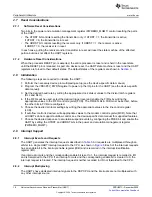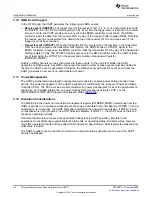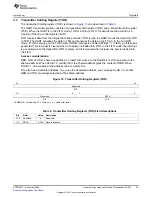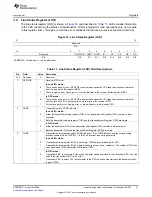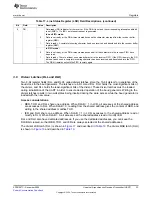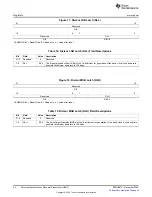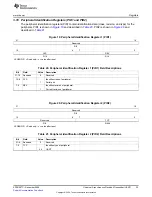
Registers
www.ti.com
Table 17. Line Status Register (LSR) Field Descriptions (continued)
Bit
Field
Value
Description
4
BI
Break indicator. The BI bit is set whenever the receive data input (RX) was held low for longer than a
full-word transmission time. A full-word transmission time is defined as the total time to transmit the
START, data, PARITY, and STOP bits. If the BI bit is set and the corresponding interrupt enable bit is
set (ELSI = 1 in IER), an interrupt request is generated.
In non-FIFO mode:
0
No break has been detected, or the BI bit was cleared because the CPU read the erroneous character
from the receiver buffer register (RBR).
1
A break has been detected with the character in the receiver buffer register (RBR).
In FIFO mode:
0
No break has been detected, or the BI bit was cleared because the CPU read the erroneous character
from the receiver FIFO and the next character to be read from the FIFO has no break indicator.
1
A break has been detected with the character at the top of the receiver FIFO.
3
FE
Framing error (FE) indicator. A framing error occurs when the received character does not have a valid
STOP bit. In response to a framing error, the UART sets the FE bit and waits until the signal on the RX
pin goes high. Once the RX signal goes high, the receiver is ready to detect a new START bit and
receive new data. If the FE bit is set and the corresponding interrupt enable bit is set (ELSI = 1 in IER),
an interrupt request is generated.
In non-FIFO mode:
0
No framing error has been detected, or the FE bit was cleared because the CPU read the erroneous
data from the receiver buffer register (RBR).
1
A framing error has been detected with the character in the receiver buffer register (RBR).
In FIFO mode:
0
No framing error has been detected, or the FE bit was cleared because the CPU read the erroneous
data from the receiver FIFO and the next character to be read from the FIFO has no framing error.
1
A framing error has been detected with the character at the top of the receiver FIFO.
2
PE
Parity error (PE) indicator. A parity error occurs when the parity of the received character does not
match the parity selected with the EPS bit in the line control register (LCR). If the PE bit is set and the
corresponding interrupt enable bit is set (ELSI = 1 in IER), an interrupt request is generated.
In non-FIFO mode:
0
No parity error has been detected, or the PE bit was cleared because the CPU read the erroneous data
from the receiver buffer register (RBR).
1
A parity error has been detected with the character in the receiver buffer register (RBR).
In FIFO mode:
0
No parity error has been detected, or the PE bit was cleared because the CPU read the erroneous data
from the receiver FIFO and the next character to be read from the FIFO has no parity error.
1
A parity error has been detected with the character at the top of the receiver FIFO.
1
OE
Overrun error (OE) indicator. An overrun error in the non-FIFO mode is different from an overrun error
in the FIFO mode. If the OE bit is set and the corresponding interrupt enable bit is set (ELSI = 1 in IER),
an interrupt request is generated.
In non-FIFO mode:
0
No overrun error has been detected, or the OE bit was cleared because the CPU read the content of
the line status register (LSR).
1
Overrun error has been detected. Before the character in the receiver buffer register (RBR) could be
read, it was overwritten by the next character arriving in RBR.
In FIFO mode:
0
No overrun error has been detected, or the OE bit was cleared because the CPU read the content of
the line status register (LSR).
1
Overrun error has been detected. If data continues to fill the FIFO beyond the trigger level, an overrun
error occurs only after the FIFO is full and the next character has been completely received in the shift
register. An overrun error is indicated to the CPU as soon as it happens. The new character overwrites
the character in the shift register, but it is not transferred to the FIFO.
32
Universal Asynchronous Receiver/Transmitter (UART)
SPRU997C – December 2009
Submit Documentation Feedback
Copyright © 2009, Texas Instruments Incorporated

